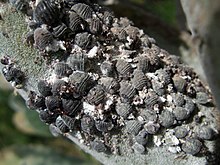Carmine
| Structural formula | ||||||||||||||||
|---|---|---|---|---|---|---|---|---|---|---|---|---|---|---|---|---|

|
||||||||||||||||
| Structural formula of carminic acid | ||||||||||||||||
| General | ||||||||||||||||
| Surname | Carmine | |||||||||||||||
| other names | ||||||||||||||||
| Molecular formula | C 22 H 20 O 13 | |||||||||||||||
| Brief description |
dark red odorless solid |
|||||||||||||||
| External identifiers / databases | ||||||||||||||||
|
||||||||||||||||
| properties | ||||||||||||||||
| Molar mass | 492.39 g mol −1 | |||||||||||||||
| Physical state |
firmly |
|||||||||||||||
| Melting point |
Decomposition from 136 ° C |
|||||||||||||||
| solubility |
almost insoluble in cold water, soluble in hot water and ethanol |
|||||||||||||||
| safety instructions | ||||||||||||||||
|
||||||||||||||||
| As far as possible and customary, SI units are used. Unless otherwise noted, the data given apply to standard conditions . | ||||||||||||||||
Carmine ( real carmine, cochineal, koschenilla ) is a red dye obtained from cochineal insects , the main component of which is carminic acid .
The dye is related to Kermes ( spurious Carmine ) consisting of scale insects is recovered from the Mediterranean, the Lac Dye from Indian lac insect , Polish cochineal (also Wurzelkermes or locust blood ) from the Polish Karminschildlaus Polish cochineal and the Armenian cochineal from cochineal Porphyrophora hameli . Sometimes the term carmine is used for all colorants obtained from scale insects.
history
In Central and South America , the dye was made from cochineal scale insects ( Dactylopius coccus Costa) that live on prickly pear cacti (opuntia). The technique of making paint was practiced in the mountains of Peru , Bolivia and Ecuador even before the arrival of the Europeans and was there and in Mexico at least since the 2nd century BC. Known. Cochineal was used to dye ritual and ceremonial manorial textiles in Peru and Mexico and used as a tribute payment in medieval Latin American cultures.
After the arrival of Europeans in America, the real carmine also spread in Europe and largely replaced the kermes. The Europeans introduced cochineal whiteflies for production in various places within their sphere of influence, including for the first time in 1826 on the Canary Islands . On La Palma , cochineal was extracted on a small scale until the 20th century. With the development of synthetic dyes from the second half of the 19th century, the importance of carmine fell sharply.
Manufacturing
The dye is obtained from pregnant female scale insects. To obtain the color, the lice are washed with vinegar and dried, then they are boiled in water with the addition of a little sulfuric acid . For lacquering as aluminum or calcium salt, the carminic acid is then precipitated, washed out and dried using alum and a little lime . After collapse , the carmine can be used as a pigment .
One kilogram of dried cochineal whitefish make about 50 grams of carmine. For this you need about 60,000 to 100,000 cochineal whiteflies. The European scale insect species contain about 10 times less dye. While the dye from the cochineal scale insect, as well as from the Armenian scale insect, contains over 94% carminic acid, the dye from the Polish scale insect only consists of 62–88% carminic acid. The dye from the Kermes scale insect consists mainly of Kermess acid .
use

color code: # 960018
Carmine is a - comparatively high-quality - substitute for the purple of the snails and results in scarlet to crimson or purple hues.
The dye is used for coloring of textiles and cosmetics , such as lipsticks , and for Paint colors used. Cochineal is approved as a food coloring E 120 and is used in colored drinks and sweets . This is how Campari used to get its red color from the cochineal lice. An inexpensive surrogate is cochineal red A , an azo dye approved as a food additive under E 124 .
The flag of Latvia with crimson stripes (Latvian red)
As a painter's paint , carmine is only slightly lightfast . It was often used as a water color or for glazes .
Carmine acetic acid is suitable for fixing and at the same time staining chromosomes (these become dark black-red) in microscopy (for genetic examinations).
toxicology
When inhaled, real carmine can trigger asthma as an aeroallergenic. Even when taken orally allergic reactions have been to anaphylaxis described in which IgE - antibodies by RAST and immunoblotting were detected.
literature
- Amy Butler Greenfield: A Perfect Red: Empire, Espionage and the Quest for the Color of Desire . HarperCollins Publisher, New York 2004, ISBN 0-06-052275-5 (English, limited preview in Google Book Search).
- Heinrich Moritz Willkomm: The cochineal . In: The Gazebo . Issue 30, 1855, pp. 398-400 ( full text [ Wikisource ]).
Web links
Individual evidence
- ↑ Entry on E 120: Cochineal, Carminic acid, Carmines in the European database on food additives, accessed on June 16, 2020.
- ↑ a b c d e entry on carmine. In: Römpp Online . Georg Thieme Verlag, accessed on March 12, 2019.
- ↑ a b data sheet Carmine, powder from Sigma-Aldrich , accessed on June 21, 2019 ( PDF ).
- ↑ M. C. Whiting: The dyes in early oriental carpets . In: Society of German Chemists (ed.): Chemistry in our time . 15th year, no. 6 . Verlag Chemie, Weinheim 1981, p. 179-189 .
- ^ E. Phipps: Cochineal Red: The Art History of a Color . The Metropolitan Museum of Art, New York 2010, ISBN 978-1-58839-361-6 , pp. 8–12 ( limited preview in Google Book search).
- ^ H. Honegger: Introduction and culture of the cochineal on the Canary Islands. In: The Zoological Garden . 20, 1879, archive.org .
- ^ W. Kükenthal, H. Strümpel: Handbuch der Zoologie. Volume 4, De Gruyter, 1983, ISBN 3-11-008856-8 , p. 81.
- ↑ I. Klöckl: Chemistry of colorants: In painting . Walter De Gruyter, Berlin / Munich / Boston 2015, ISBN 978-3-11-037451-3 , p. 293 f . ( limited preview in Google Book search).
- ^ C. Watt, J. Watt Jr .: The Chemist: Or, Reporter of Chemical Discoveries and Improvements, and Protector of the Rights of the Chemist and Chemical Manufacturer . R. Hastings, London 1840, p. 209–210 ( limited preview in Google Book search).
- ↑ Major Colors and Dyestuff: Cochineal and Carmine on fao.org, accessed July 17, 2018.
- ↑ J. Best: Color Design. Elsevier, 2017, ISBN 978-0-08-101270-3 , p. 562.
- ↑ HALI: The International Journal of Oriental Carpets and Textiles. Issues 111–113, Oguz Press, 2000, p. 61.
- ↑ ZZulV : Annex 1 (to Section 3, Paragraph 1 and Section 7) Additives that are approved for coloring food or for achieving color effects on food .
- ↑ A. I. Tabar, S. Acero, C. Arregui, M. Urdánoz, S. Quirce: Asthma and allergy due to carmine dye. In: Anales del sistema sanitario de Navarra. Volume 26, Suppl. 2, 2003, pp. 65-73, ISSN 1137-6627 , PMID 13679965 .
- ↑ L. Jäger, B. Wüthrich, B. Ballmer-Weber, St. Vieths (eds.): Food allergies and intolerances: Immunology - Diagnostics - Therapy - Prophylaxis. 3. Edition. Elsevier, Urban & Fischer, 2008, ISBN 978-3-437-21362-5 , p. 224.




